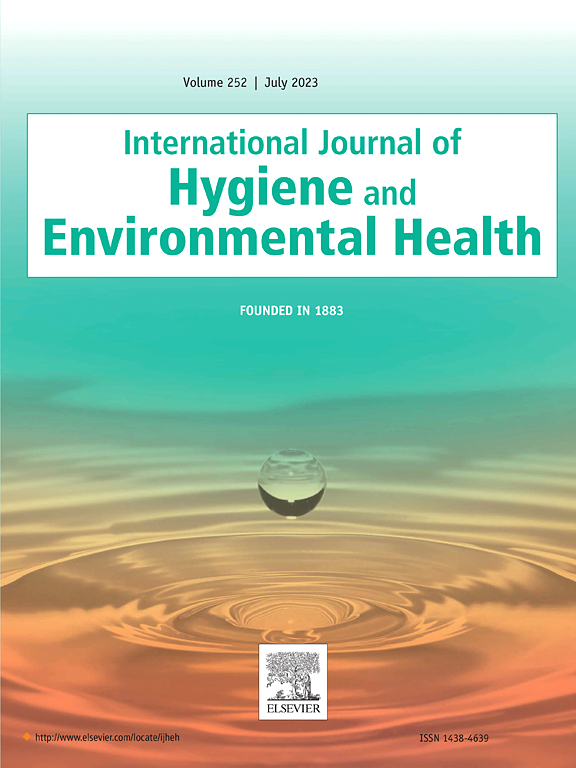子宫内接触邻苯二甲酸酯、对羟基苯甲酸酯和其他酚类化合物与青少年月经周期特征的关系
IF 4.4
2区 医学
Q1 INFECTIOUS DISEASES
International journal of hygiene and environmental health
Pub Date : 2025-06-29
DOI:10.1016/j.ijheh.2025.114612
引用次数: 0
摘要
邻苯二甲酸酯、对羟基苯甲酸酯和其他酚类物质存在于人类每天使用的消费品中,包括个人护理产品和食品包装。接触这些化学物质可能会造成内分泌紊乱。月经周期是由荷尔蒙的涨落所引导的,而荷尔蒙的涨落可能会因接触这些化学物质而受到干扰。在一个以拉丁裔农场工人为主的队列中,研究了怀孕期间母亲尿液中邻苯二甲酸酯、对羟基苯甲酸酯和酚类代谢物的浓度及其16岁女儿的几个月经周期特征。使用逻辑回归检查了化学物质与每个结果之间的关联。贝叶斯分层模型用于模拟化学混合物与每个结果的关联。所有模型都根据怀孕期间的贫困水平、母亲孕前BMI和青少年9岁时的快餐消费进行了调整。结果显示,邻苯二甲酸单(3-羧基丙基)酯、对羟基苯甲酸丙酯和双酚a与月经量增加呈正相关。暴露于2,4-二氯苯酚与短周期长度呈正相关。邻苯二甲酸一(3-羧基丙基)和邻苯二甲酸二(2-乙基己基)与长周期长度呈正相关。这些结果表明,子宫内接触邻苯二甲酸酯、对羟基苯甲酸酯和其他酚类物质可能与青少年月经周期异常特征有关。本文章由计算机程序翻译,如有差异,请以英文原文为准。
In utero exposure to a mixture of phthalates, parabens, and other phenols and menstrual cycle characteristics in adolescents
Phthalates, parabens, and other phenols are present in consumer products humans use every day, including personal care products and food packaging. Exposure to these chemicals may have endocrine disrupting effects. The menstrual cycle is guided by the rise and fall of hormones, which may be disrupted by exposure to these chemicals. Urinary concentrations of metabolites of phthalates, parabens, and phenols in mothers during pregnancy and several menstrual cycle characteristics in their daughters at age 16 were examined in a predominantly Latino farmworker cohort. The association between the chemicals and each outcome was examined using logistic regression. Bayesian hierarchical modeling was used to model the chemical mixture's associations with each outcome. All models were adjusted for poverty level during pregnancy, maternal pre-pregnancy BMI, and fast-food consumption at adolescent age 9. Results showed a positive association between mono (3-carboxypropyl) phthalate, propylparaben, and bisphenol-A and heavy menstrual flow. Exposure to 2,4-dichlorophenol was positively associated with short cycle length. Mono(3-carboxypropyl) phthalate and di (2-ethylhexyl) phthalate were positively associated with long cycle length. These results suggest in utero exposure to phthalates, parabens, and other phenols may be associated with abnormal menstrual cycle characteristics in adolescents.
求助全文
通过发布文献求助,成功后即可免费获取论文全文。
去求助
来源期刊
CiteScore
11.50
自引率
5.00%
发文量
151
审稿时长
22 days
期刊介绍:
The International Journal of Hygiene and Environmental Health serves as a multidisciplinary forum for original reports on exposure assessment and the reactions to and consequences of human exposure to the biological, chemical, and physical environment. Research reports, short communications, reviews, scientific comments, technical notes, and editorials will be peer-reviewed before acceptance for publication. Priority will be given to articles on epidemiological aspects of environmental toxicology, health risk assessments, susceptible (sub) populations, sanitation and clean water, human biomonitoring, environmental medicine, and public health aspects of exposure-related outcomes.

 求助内容:
求助内容: 应助结果提醒方式:
应助结果提醒方式:


